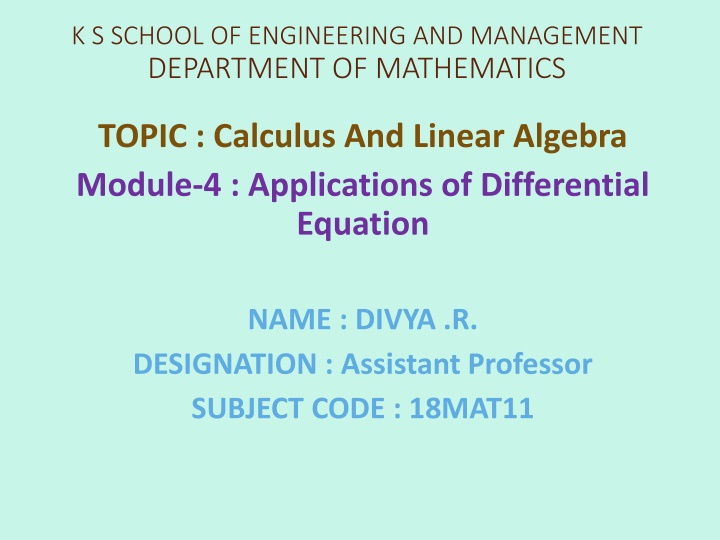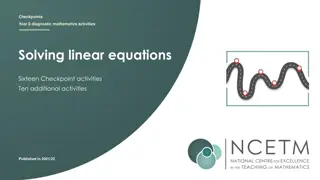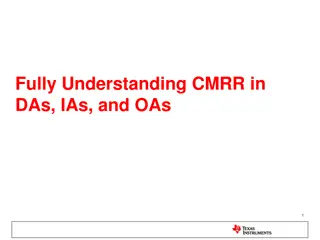Applications of Differential Equations in Engineering and Mathematics
Exploring the practical applications of differential equations, specifically focusing on Newton's Law of Cooling and Orthogonal Trajectories. The concept of exact differential equations and their solutions, along with real-life examples demonstrating temperature changes over time, are discussed. Understanding how differential equations are utilized in various scenarios within the realms of engineering and mathematics.
Download Presentation

Please find below an Image/Link to download the presentation.
The content on the website is provided AS IS for your information and personal use only. It may not be sold, licensed, or shared on other websites without obtaining consent from the author.If you encounter any issues during the download, it is possible that the publisher has removed the file from their server.
You are allowed to download the files provided on this website for personal or commercial use, subject to the condition that they are used lawfully. All files are the property of their respective owners.
The content on the website is provided AS IS for your information and personal use only. It may not be sold, licensed, or shared on other websites without obtaining consent from the author.
E N D
Presentation Transcript
K S SCHOOL OF ENGINEERING AND MANAGEMENT DEPARTMENT OF MATHEMATICS TOPIC : Calculus And Linear Algebra Module-4 : Applications of Differential Equation NAME : DIVYA .R. DESIGNATION : Assistant Professor SUBJECT CODE : 18MAT11
1.Newtons Law of Cooling 2.LCR circuits 3.Problems on beams 4.Orthogonal Trajectories
Differential Equation Exact Differential Equations: The differential equation M(x , y) dx + N(x , y)dy=0 to be an exact equation is M/ y = N/ x Further the solution of the exact equation is given by M dx + N ( y )dy= c We integrate M(x,y) w.r.t x keeping y fixed and N(y) indicate the terms in N does not contain x
Application : Newton's Law of Cooling Application : Newton's Law of Cooling It is a model that describes, mathematically, the change in temperature of an object in a given environment. The law states that the rate of change (in time) of the temperature is proportional to the difference between the temperature T of the object and the temperature Te of the environment surrounding the object. d T / d t = - k (T - Te) Let x = T Te so that dx / dt = dT / dt Using the above change of variable, the above differential equation becomes d x / d t = - k x The solution to the above differential equation is given by x = A e- k t
substitute x by T - Te T - Te = A e- k t Assume that at t = 0 the temperature T = To To - Te = A e0 which gives A = To - Te The final expression for T(t) i given by T(t) = Te + (To - Te)e- k t This last expression shows how the temperature T of the object changes with time.
Real life examples A coffee of 98 degree centigrade will take 30 minutes to come down to 45 degree centigrade in a room of temperature 30 degree centigrade A dosa tava will take at teast 20 minutes to come down from 240 degree centigrade to 80 degree centigrade so that we can put it in wash basin.
Orthogonal Trajectories(OT) Trajectory: A curve which cuts every member of a given family of curves according to some definite law . Orthogonal Trajectory: A curve which cuts every member of a given family of curves at right angles .
Examples Orthogonal trajecteries for concentric circles is family of stright lines passing through origin Orthogonal trajecteries for cardioids R=a(1+cos t) is r=a(1+sint)
Working rule to find the equation of OT in Working rule to find the equation of OT in Cartesian form Cartesian form Cartesian curves f(x,y,c)=0 1.Differentiate and eliminate the arbitrary constant c and the resulting equation if f(x,y,dy/dx)=0 2.Replace dy/dx by dx/dy 3. The diff equation of the form f(x,y,-dx/dy)=0 4.Solve the diff. equation to get the required O.T
Working rule to find the equation of OT in Polar form Polar curves f(r, ,c)=0 1.Diff and eliminate the arbitrary constant c and the resulting equation if f(r, ,dr/d )=0 2.Replace dr/d by r2d /dr 3. The diff equation of the form f(r, , r2d /dr)=0 4.Solve the diff. equation to get the required O.T
https://nptel.ac.in/courses/111/106/111106100/ This NPTEL video link contains differential equations of first order and higher order with applications. THANK YOU























